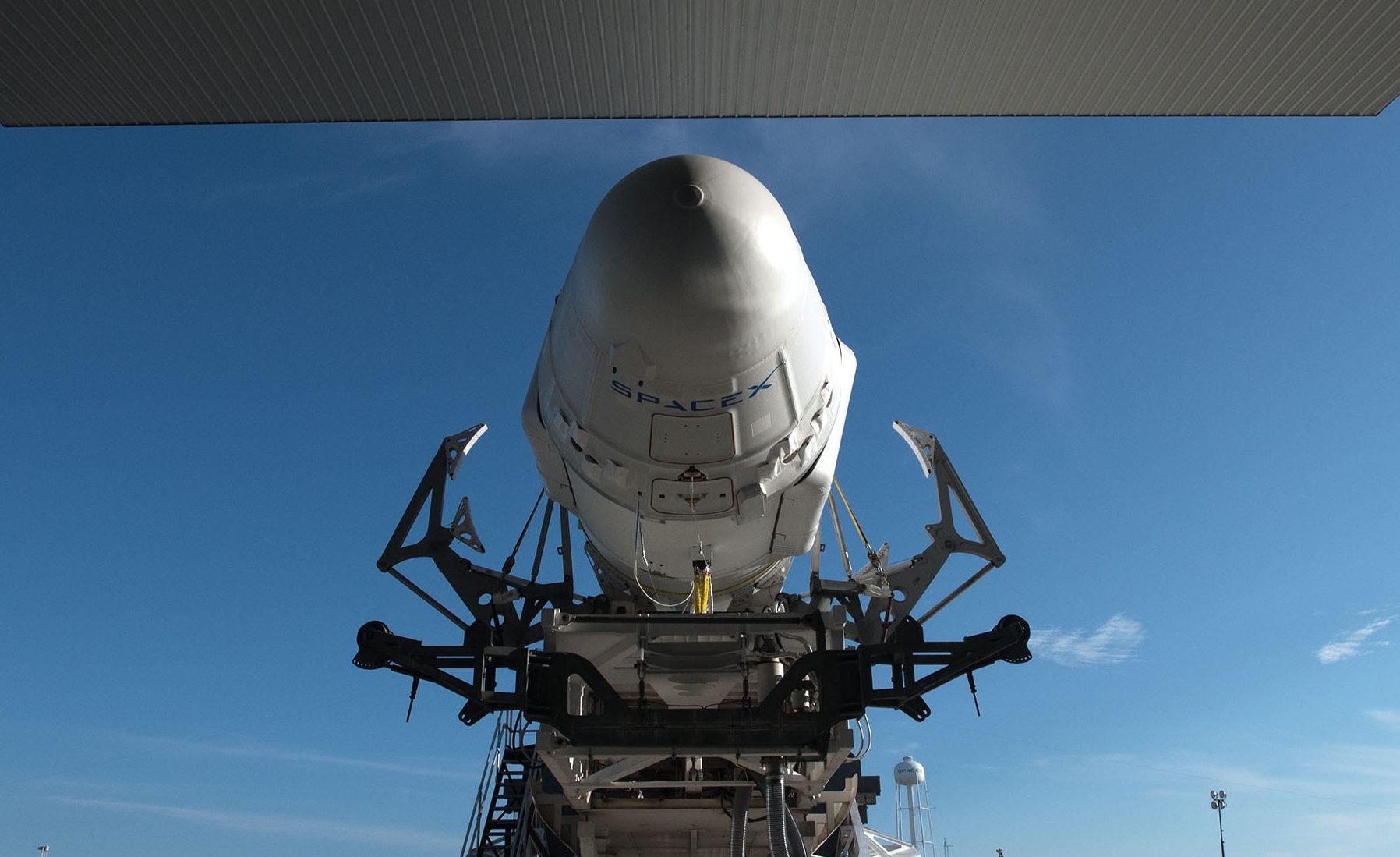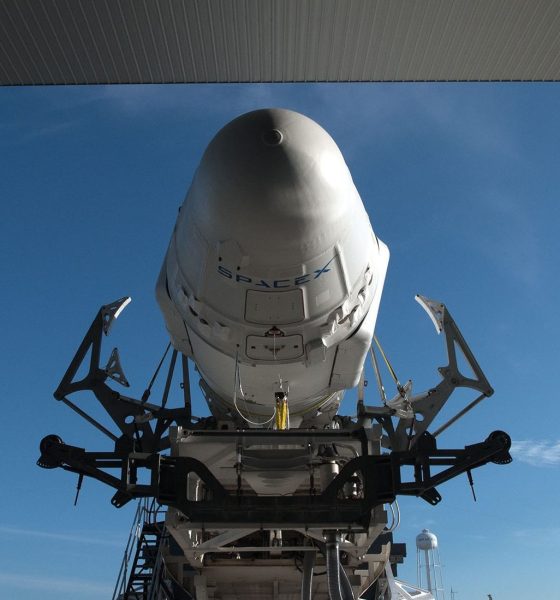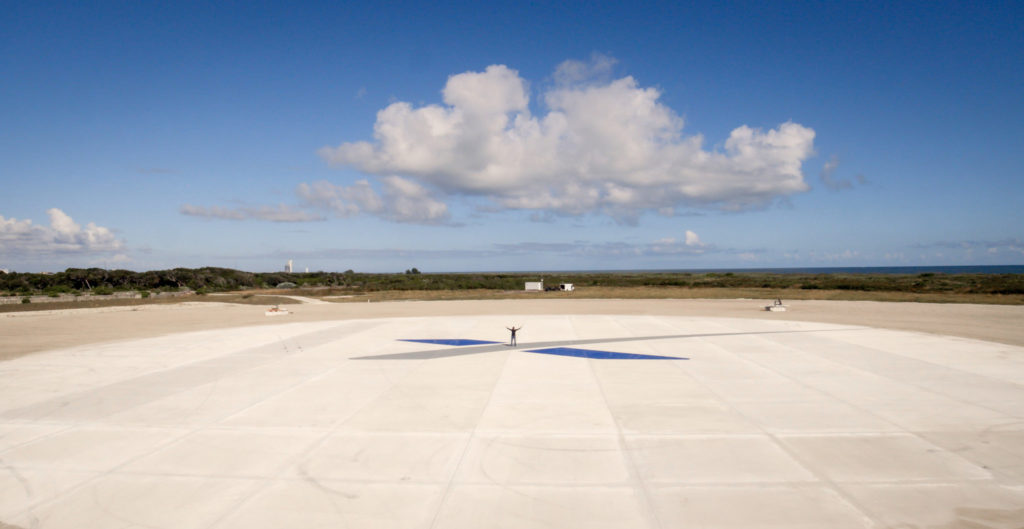

News
SpaceX and NASA are go for the 12th Cargo Dragon launch on Monday
Just under 24 hours ahead of the launch of CRS-12, NASA and SpaceX provided information about the mission earlier this morning during a pre-launch press conference.
NASA confirmed once more that tomorrow’s launch attempt will be the only slot available until August 19th or 20th, due to a planned EVA (extra vehicular activity) that will involve the launch of cubesats around the ISS. As a result of safety restrictions, cargo and crew spacecraft are not allowed to approach the International Space Station while crew are outside, nor while satellites launched from the station have yet to have their orbits characterized. The United Launch Alliance has a launch planned for August 18th or 19th, with SpaceX able to make a second attempt after ULA’s launch, if necessary.

CRS-12’s Dragon and Falcon 9 1039 horizontal at LC-39A ahead of a launch attempt on Monday.
(NASASpaceflight /u/Craig_VG)
Revealed by NASASpaceflight.com in an article posted yesterday, “some but not all of the Block 5 upgrades, including some incremental upgrades like increased engine thrust, will debut…on the CRS-12 launch”. Hans Koenigsmann, the Vice President of Mission Assurance at SpaceX, was not aware of specific differences between past launches, but did not deny that there would be some level of incremental improvements present for the launch of CRS-12. Interestingly, Gebhardt also reported that Falcon 9 Block 5, intended to be a highly reusable “final” version of the vehicle, is expected to take flight for the first time during SpaceX’s first Commercial Crew Demo-1 launch as soon as February 2018.
Koenigsmann further confirmed that the launch of CRS-12 would make use of reused landing legs, although their origin is unknown. As far as he was aware, the legs are the only reused hardware that will be present during the launch.
The lack of backup attempts for CRS-12’s launch means that more focus is being placed on weather conditions at the launch site. As of several days ago, weather forecasts were looking negative for the launch and suggesting a 70% or greater chance of conditions that would prevent a launch attempt. However, this has flipped around over the last 24 hours, and the probably of weather violations is now only 30%. The Air Force’s 45th Space Wing did release a report today indicating that conditions after the launch may make safing the landed first stage more difficult for SpaceX, with an increased potential for rain and lightning.

If all goes well, core 1039 will attempt a landing tomorrow afternoon at SpaceX’s Landing Zone 1 (LZ-1). (SpaceX)
Also discussed briefly during the press conference, necessary modifications to the LC-39A pad are still set to occur this fall ahead of Falcon Heavy’s inaugural launch before the end of the year. LC-40 is also progressing nicely and while Koenigsmann stated that SpaceX had not as of yet decided on the first mission to fly from the reactivated pad, it is currently expected to be SES-11 sometime early in the fourth quarter of 2017. SES-11 has also been hinted to be launching aboard a reused Falcon 9 first stage, and would make for a fitting return to operational status for the pad.
In other news, CRS-13, which will fly with a refurbished Dragon spacecraft, is now set to launch no earlier than December 2017. Previously aiming for a November launch, it has almost certainly been pushed back as a result of Orbital-ATK choosing to slightly delay their next launch of their Cygnus spacecraft until November. This extra time will allow OATK to accommodate more cubesat payloads during that launch, and the delays of Cygnus’ OA-7 mission or Dragon’s CRS-13 launch are anticipated to be the result of technical issues.
Catch the first launch attempt of CRS-12 live tomorrow at the link below! The expected moment of liftoff is approximately 12:31 p.m. EST, 9:31 a.m. PST.

Elon Musk
Elon Musk’s X will start using a Tesla-like software update strategy
The initiative seems designed to accelerate updates to the social media platform, while maintaining maximum transparency.

Elon Musk’s social media platform X will adopt a Tesla-esque approach to software updates for its algorithm.
The initiative seems designed to accelerate updates to the social media platform, while maintaining maximum transparency.
X’s updates to its updates
As per Musk in a post on X, the social media company will be making a new algorithm to determine what organic and advertising posts are recommended to users. These updates would then be repeated every four weeks.
“We will make the new 𝕏 algorithm, including all code used to determine what organic and advertising posts are recommended to users, open source in 7 days. This will be repeated every 4 weeks, with comprehensive developer notes, to help you understand what changed,” Musk wrote in his post.
The initiative somewhat mirrors Tesla’s over-the-air update model, where vehicle software is regularly refined and pushed to users with detailed release notes. This should allow users to better understand the details of X’s every update and foster a healthy feedback loop for the social media platform.
xAI and X
X, formerly Twitter, has been acquired by Elon Musk’s artificial intelligence startup, xAI last year. Since then, xAI has seen a rapid rise in valuation. Following the company’s the company’s upsized $20 billion Series E funding round, estimates now suggest that xAI is worth tens about $230 to $235 billion. That’s several times larger than Tesla when Elon Musk received his controversial 2018 CEO Performance Award.
As per xAI, the Series E funding round attracted a diverse group of investors, including Valor Equity Partners, Stepstone Group, Fidelity Management & Research Company, Qatar Investment Authority, MGX, and Baron Capital Group, among others. Strategic partners NVIDIA and Cisco Investments also continued support for building the world’s largest GPU clusters.
News
Tesla FSD Supervised wins MotorTrend’s Best Driver Assistance Award
The decision marks a notable reversal for the publication from prior years, with judges citing major real-world improvements that pushed Tesla’s latest FSD software ahead of every competing ADAS system.

Tesla’s Full Self-Driving (Supervised) system has been named the best driver-assistance technology on the market, earning top honors at the 2026 MotorTrend Best Tech Awards.
The decision marks a notable reversal for the publication from prior years, with judges citing major real-world improvements that pushed Tesla’s latest FSD software ahead of every competing ADAS system. And it wasn’t even close.
MotorTrend reverses course
MotorTrend awarded Tesla FSD (Supervised) its 2026 Best Tech Driver Assistance title after extensive testing of the latest v14 software. The publication acknowledged that it had previously criticized earlier versions of FSD for erratic behavior and near-miss incidents, ultimately favoring rivals such as GM’s Super Cruise in earlier evaluations.
According to MotorTrend, the newest iteration of FSD resolved many of those shortcomings. Testers said v14 showed far smoother behavior in complex urban scenarios, including unprotected left turns, traffic circles, emergency vehicles, and dense city streets. While the system still requires constant driver supervision, judges concluded that no other advanced driver-assistance system currently matches its breadth of capability.
Unlike rival systems that rely on combinations of cameras, radar, lidar, and mapped highways, Tesla’s FSD operates using a camera-only approach and is capable of driving on city streets, rural roads, and freeways. MotorTrend stated that pure utility, the ability to handle nearly all road types, ultimately separated FSD from competitors like Ford BlueCruise, GM Super Cruise, and BMW’s Highway Assistant.
High cost and high capability
MotorTrend also addressed FSD’s pricing, which remains significantly higher than rival systems. Tesla currently charges $8,000 for a one-time purchase or $99 per month for a subscription, compared with far lower upfront and subscription costs from other automakers. The publication noted that the premium is justified given FSD’s unmatched scope and continuous software evolution.
Safety remained a central focus of the evaluation. While testers reported collision-free operation over thousands of miles, they noted ongoing concerns around FSD’s configurable driving modes, including options that allow aggressive driving and speeds beyond posted limits. MotorTrend emphasized that, like all Level 2 systems, FSD still depends on a fully attentive human driver at all times.
Despite those caveats, the publication concluded that Tesla’s rapid software progress fundamentally reshaped the competitive landscape. For drivers seeking the most capable hands-on driver-assistance system available today, MotorTrend concluded Tesla FSD (Supervised) now stands alone at the top.
News
Elon Musk’s Grokipedia surges to 5.6M articles, almost 79% of English Wikipedia
The explosive growth marks a major milestone for the AI-powered online encyclopedia, which was launched by Elon Musk’s xAI just months ago.

Elon Musk’s Grokipedia has grown to an impressive 5,615,201 articles as of today, closing in on 79% of the English Wikipedia’s current total of 7,119,376 articles.
The explosive growth marks a major milestone for the AI-powered online encyclopedia, which was launched by Elon Musk’s xAI just months ago. Needless to say, it would only be a matter of time before Grokipedia exceeds English Wikipedia in sheer volume.
Grokipedia’s rapid growth
xAI’s vision for Grokipedia emphasizes neutrality, while Grok’s reasoning capabilities allow for fast drafting and fact-checking. When Elon Musk announced the initiative in late September 2025, he noted that Grokipedia would be an improvement to Wikipedia because it would be designed to avoid bias.
At the time, Musk noted that Grokipedia “is a necessary step towards the xAI goal of understanding the Universe.”
Grokipedia was launched in late October, and while xAI was careful to list it only as Version 0.1 at the time, the online encyclopedia immediately earned praise. Wikipedia co-founder Larry Sanger highlighted the project’s innovative approach, noting how it leverages AI to fill knowledge gaps and enable rapid updates. Netizens also observed how Grokipedia tends to present articles in a more objective manner compared to Wikipedia, which is edited by humans.
Elon Musk’s ambitious plans
With 5,615,201 total articles, Grokipedia has now grown to almost 79% of English Wikipedia’s article base. This is incredibly quick, though Grokipedia remains text-only for now. xAI, for its part, has now updated the online encyclopedia’s iteration to v0.2.
Elon Musk has shared bold ideas for Grokipedia, including sending a record of the entire knowledge base to space as part of xAI’s mission to preserve and expand human understanding. At some point, Musk stated that Grokipedia will be renamed to Encyclopedia Galactica, and it will be sent to the cosmos.
“When Grokipedia is good enough (long way to go), we will change the name to Encyclopedia Galactica. It will be an open source distillation of all knowledge, including audio, images and video. Join xAI to help build the sci-fi version of the Library of Alexandria!” Musk wrote, adding in a later post that “Copies will be etched in stone and sent to the Moon, Mars and beyond. This time, it will not be lost.”








